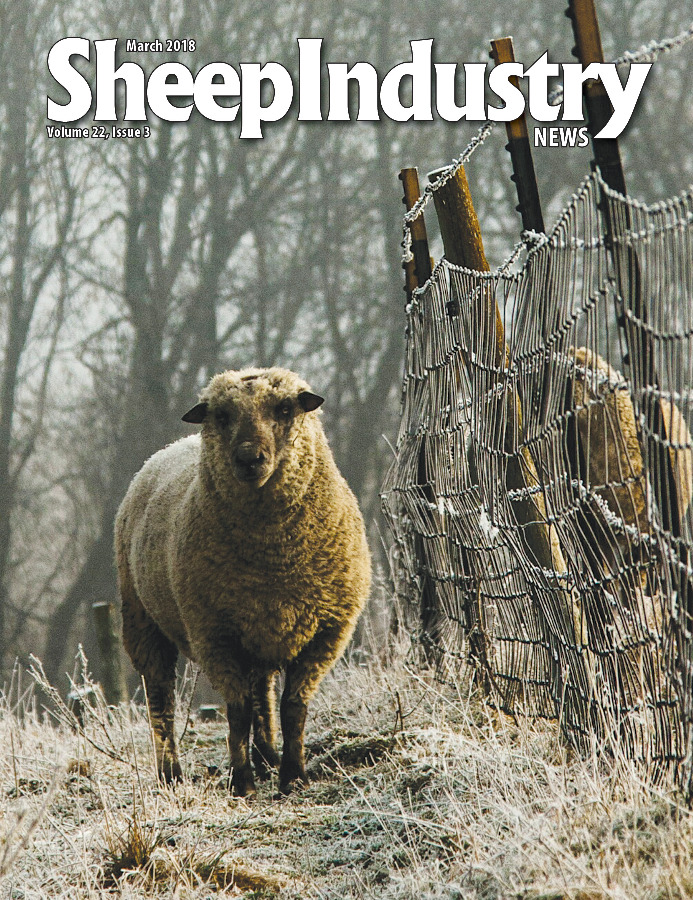
- March 2018
- President’s Notes
- Jerry King Cartoon
- Convention: Sheep Producers Share Concerns with USDA
- Convention: Industry Leaders Recognized
- Convention: MIWW Celebrates 70 Years
- Convention: American Wool Uses Technology
- Convention: Nourish With Lamb Spreads Message
- Convention: PERC Discusses Possible FMD Outbreak
- Convention: Kangols Top Guard Dog Breed
- Convention: Genetic Stakeholders Understand Value of Data
- Convention: Sheep Disease Updates
- Convention: Resource Management Eyes Progress
- Convention: Young Entrepreneurs
- Electronic Grading Approved at Superior Farms
- ALB Picks Denver as Next Target Market
- Wool is Popular at Outdoor Show
- Sheep Inventory Flat in 2017
- Feedlot Report Available
- Young Entrepreneur: Jake Kerr
- Sec. Perdue Names ALB Appointees
- Three Appointed to Sheep Center
- Around the States
- Market Report
- The Last Word
Nourish With Lamb Spreads Industry Message to Consumers
CAT URBIGKIT
The Shepherd
The Nourish With Lamb educational campaign is taking advantage of the current food renaissance in America, Allison Beadle told the Lamb Council/American Lamb Board’s session at the ASI Annual Convention.
Beadle said there are four major food trends that appear to be fueled and driven by what’s happening in the packaged goods industry:
1. Sustainable nutrition, which combines sustainability and nutrition/healthy eating. Consumers are seeking food that is healthy for their bodies and healthy for the planet. The answer, of course, is lamb.
2. Plant-based eating has resulted in numerous new product launches, and the incorporation of plant-based ingredients in these new products.
3. “Clean” meat includes meats made from plants. This trend is getting some ink in media, but hasn’t yet taken hold with consumers, even though huge amounts of money are being invested in this industry. There are also investments being made in using technology to create substitutes for meat (cell-culture created meats).
4. Regenerative agriculture, which is focused on health of the soil, and is livestock-friendly. This trend is coming on strong, driven primarily by the packaged food industry, according to Beadle. Regenerative ag promotes itself as a step ahead of organic, or better than organic.
Current lamb nutritional promotions are focused on elevating the understanding and appreciation of lamb as a protein to feel good. The campaign targets a health professional audience, and nutrition influencers such as writers, bloggers, cookbook authors, editors, as well as social media influencers who develop food and wellness content, and health professionals involved in educating consumers.
The target market is millennial consumers, and the focus for 2018 is culinary medicine – tapping into the food as medicine trend. Beadle said it’s a very exciting time to be educating health professionals about food that is not only good for you, but is absolutely delicious.
“Lamb is one food that fits both characteristics,” she said.
Tulane Medical School now has a center for culinary medicine that is focused on educating health professionals on food and cooking. The campaign partnered with Tulane to host a lamb immersion workshop for a day and a half last fall, teaching about farming, butchering, nutrition and cooking. Two similar workshops are scheduled this year at Tulane.
Lamb is a delicious, easy to cook meat, with a wonderful backstory, Beadle said, and that’s the message of NourishWithLamb.com.
Producers attending the Lamb Council/ALB session also sat in on a variety of other presentations.
Texas A&M ag economist David Anderson said there are overriding themes in the upcoming lamb market: a growing threat of drought throughout much of the United States; record meat and poultry production; and growing consumer confidence. Anderson said last year saw much of the cold storage inventory worked off, and the United States saw an increase in lamb imports as the lamb market experienced price growth in the second half of last year.
Brad Anderson of Mountain States Rosen and Lesa Eidman of Superior Farms talked about progress in electronic grading systems, and North Dakota State University extension sheep specialist Travis Hoffman talked about the issues in defining lamb. Hoffman said that when asked, “What is lamb?” more survey respondents replied that it was a young animal than thought of lamb as a red meat alternative.
Are various meat products lamb or mutton? Meat from an ovine carcass is generally labeled as lamb, sheep or mutton. Lamb is defined in a variety of ways, including an animal less than a year old, less than 14 months old, the presence of a foreleg break joint, or the non-eruption of the first pair of permanent incisors.
Hoffman reported that the U.S. Department of Agriculture Food Safety and Inspection Service has indicated that to label a product as lamb that does not meet its policy on lamb labeling is false and misleading. The USDA/FSIS policy defines a young sheep or lamb carcasss as the presence of a break joint; written documentation that the ovine is less than 14 months of age; or the non-eruption of the first pair of permanent incisors.

